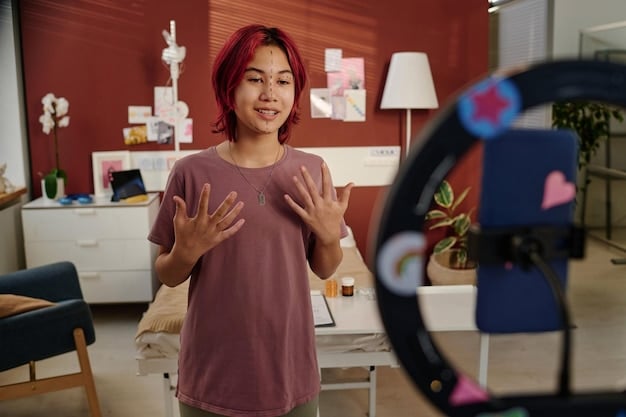The Rise of Virtual Influencers: Industry Takeover?

Anúncios
Virtual influencers are computer-generated characters who are rapidly gaining popularity on social media, blurring the lines between reality and digital marketing, and sparking debates about their potential to reshape the influencer industry.
Anúncios
The digital landscape is constantly evolving, and one of the most intriguing developments in recent years has been the rise of virtual influencers: Are They Taking Over the Industry? These computer-generated characters are not only capturing the attention of millions but also reshaping the way brands connect with consumers.
What are Virtual Influencers?
Virtual influencers, also known as CGI influencers, are digital characters created using computer graphics software. These characters have realistic appearances and personalities, and they are designed to engage with audiences on social media platforms like Instagram, TikTok, and YouTube.
Anúncios
Unlike human influencers, virtual influencers are entirely fictional. They don’t exist in the real world, but they lead incredibly lifelike digital lives. They post photos, share stories, and interact with their followers, just like any human influencer.
Key Characteristics of Virtual Influencers
Several characteristics define virtual influencers and set them apart from their human counterparts:
- Realism: Virtual influencers are designed to look as realistic as possible, with intricate details in their appearance and movements.
- Personality: They are given distinct personalities and backstories, allowing them to connect with audiences on an emotional level.
- Consistency: Brands have complete control over the messaging and image of virtual influencers, ensuring consistency across all platforms.
Virtual influencers have become increasingly sophisticated, making it harder to distinguish them from real people. This has led to both excitement and debate about the future of the influencer industry.
The Growing Popularity of Virtual Influencers
The popularity of virtual influencers has exploded in recent years, with many of these digital characters amassing millions of followers. This growth can be attributed to several factors, including their novelty, engagement, and the control they offer to brands.
Brands are drawn to virtual influencers because they offer a safe and predictable way to promote their products. There’s no risk of a virtual influencer getting into a scandal or making controversial statements.

Factors Driving Their Popularity
Several factors contribute to the growing popularity of virtual influencers:
- Novelty: Virtual influencers are still a relatively new phenomenon, and their novelty attracts a lot of attention.
- Engagement: They often have high engagement rates, as their followers are curious about their digital lives.
- Control: Brands have complete control over the messaging and image of virtual influencers.
- Cost-Effective: In many instances, they can be more cost-effective than traditional influencers.
As technology continues to advance, virtual influencers are only likely to become more popular. Brands are investing heavily in this space, and new virtual influencers are popping up all the time.
Benefits of Using Virtual Influencers for Brands
There are several benefits for brands that choose to work with virtual influencers. These include increased control, cost savings, and the ability to reach new audiences.
Virtual influencers can be programmed to say exactly what a brand wants them to say, without any risk of them going off-script. This can be a major advantage for brands that are particularly sensitive about their messaging.
Control and Consistency
One of the biggest benefits of using virtual influencers is the level of control they offer to brands:
- Messaging: Brands have complete control over what virtual influencers say and do.
- Brand Image: They can ensure that virtual influencers always align with their brand image.
- Consistency: Virtual influencers can maintain a consistent presence across all platforms.
This level of control is simply not possible with human influencers, who have their own opinions and values. Virtual influencers are essentially brand ambassadors, and they can be trusted to always represent the brand in a positive light.
The Ethical Considerations of Virtual Influencers
The rise of virtual influencers has also raised several ethical concerns. These include the potential for deception, the impact on body image, and the lack of transparency.
Some critics argue that virtual influencers are deceptive because they are not real people. They worry that consumers may not realize that they are being marketed to by a computer-generated character.

Transparency and Disclosure
Transparency is crucial when it comes to virtual influencers. Brands and creators should be upfront about the fact that these characters are not real.
Without proper disclosure, consumers may be misled into thinking that they are interacting with a real person. This can erode trust and damage the credibility of both the brand and the virtual influencer.
Impact on Body Image
There are also concerns about the impact of virtual influencers on body image. Many of these characters are designed to be physically perfect, and this can create unrealistic expectations for viewers.
Studies have shown that exposure to idealized images can lead to body dissatisfaction and low self-esteem. It’s important for consumers to be aware that virtual influencers are not real and that their appearances are often unattainable.
Virtual Influencers vs. Human Influencers
While virtual influencers offer several advantages, they also have their limitations. Human influencers bring authenticity, relatability, and real-world experience to the table.
Human influencers can connect with their audiences on a deeper level because they are real people with real stories. They can share their experiences, offer advice, and provide support in a way that virtual influencers cannot.
The Strengths of Human Influencers
Human influencers offer several unique strengths:
- Authenticity: They are real people with real stories.
- Relatability: They can connect with their audiences on a personal level.
- Experience: They can share their expertise and offer valuable insights.
Ultimately, the decision of whether to work with a virtual or human influencer depends on the specific goals of the brand. Virtual influencers may be a good choice for brands that want complete control over their messaging, while human influencers may be a better choice for brands that want to connect with their audiences on a deeper level.
The Future of Virtual Influencers
The future of virtual influencers looks bright. As technology continues to advance, these digital characters are becoming more realistic and sophisticated.
We can expect to see even more brands investing in virtual influencers in the years to come. These characters offer a unique and effective way to reach consumers, and they are likely to play an increasingly important role in the marketing landscape.
The rise of virtual influencers is changing the marketing and advertising world by providing brands and companies with a new means of connecting with consumers. These virtual figures blur the barrier between the digital and physical worlds, providing interesting opportunities for marketers and new obstacles. But what does that really entail for things to come?
Predictions for the Future
Here are some predictions for the future of virtual influencers:
- More Realism: Virtual influencers will become even more realistic and lifelike.
- Greater Integration: They will be integrated into more aspects of our lives, from advertising to entertainment.
- Increased Competition: The market for virtual influencers will become more crowded, leading to increased competition.
Virtual influencers are here to stay, and they are likely to have a major impact on the future of marketing. Brands that embrace this technology will be well-positioned to succeed in the years to come.
| Key Point | Brief Description |
|---|---|
| 🤖 What are Virtual Influencers? | CGI or computer generated characters acting as influencers. |
| 📈 Growing Popularity | Driven by novelty, engagement, and brand control. |
| ✅ Benefits for Brands | Increased control, cost savings, and new audience reach. |
| 🤔 Ethical Considerations | Potential for deception, body image impact, and lack of transparency. |
FAQ
▼
No, virtual influencers are not real people. They are computer-generated characters created using CGI (Computer-Generated Imagery) technology. They are designed to look and act like real influencers.
▼
Brands use virtual influencers for greater control over content, cost-effectiveness, and to target specific demographics. They can create consistent brand messaging without the risks associated with human influencers.
▼
Ethical concerns include lack of transparency, potential for deception, impact on body image, and authenticity. It’s important for brands to disclose that these influencers are not real.
▼
Virtual influencers challenge the traditional influencer model by providing a new form of digital representation. They can disrupt the industry but also create opportunities for collaboration between human and virtual influencers.
▼
The future of virtual influencers involves more realism, integration into various aspects of life, and increased competition. They are expected to become even more sophisticated and play a significant role in marketing.
Conclusion
In conclusion, the rise of virtual influencers is a complex phenomenon with both exciting opportunities and significant challenges. While they offer brands unprecedented control and creative potential, it’s essential to consider the ethical implications and potential impact on audiences. As technology evolves, virtual influencers will likely continue to shape the digital landscape and redefine what it means to be an influencer.





